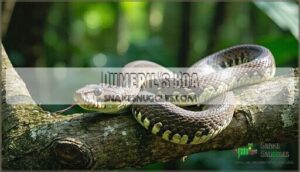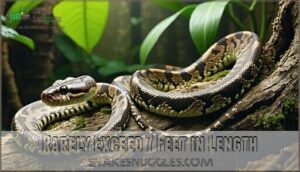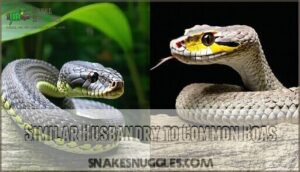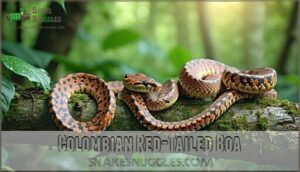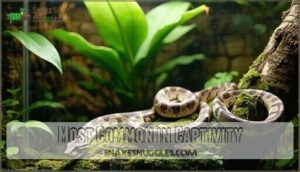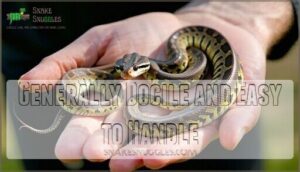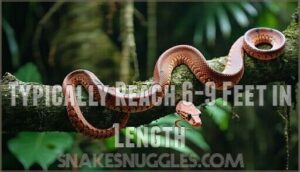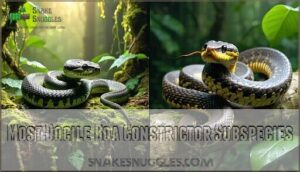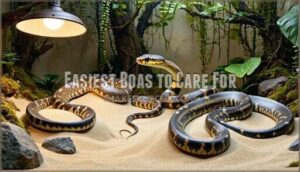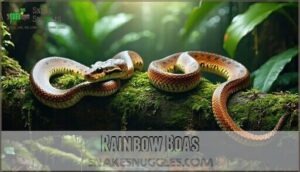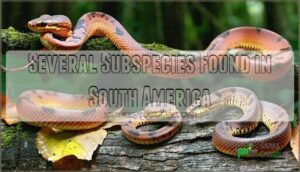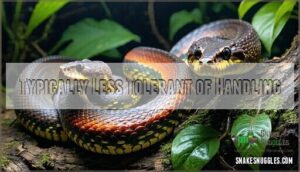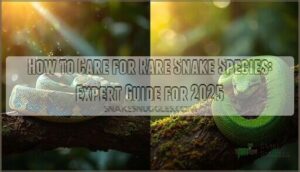This site is supported by our readers. We may earn a commission, at no cost to you, if you purchase through links.
 When you’re hunting for the best pet boas, you’ll want to master the art of species selection. Colombian Red-Tailed Boas rule the roost as top choices, reaching 6-9 feet with surprisingly gentle temperaments that won’t leave you wrestling a serpent.
When you’re hunting for the best pet boas, you’ll want to master the art of species selection. Colombian Red-Tailed Boas rule the roost as top choices, reaching 6-9 feet with surprisingly gentle temperaments that won’t leave you wrestling a serpent.
Dumeril’s Boas offer an even smoother entry point, staying under 7 feet while delivering the same rewarding experience. These aren’t your average pets – they’re 20-30 year commitments that transform novice keepers into confident handlers.
Common Boas (Boa constrictor imperator) provide excellent middle ground with their docile nature and manageable size. The secret lies in matching temperament with your experience level, and understanding which subspecies will become your perfect scaly companion.
Table Of Contents
- Key Takeaways
- Choosing The Right Boa Constrictor for You
- Best Boas for Beginners
- Most Docile Boa Constrictor Subspecies
- Easiest Boas to Care For
- Boa Constrictor Subspecies for Experienced Owners
- Frequently Asked Questions (FAQs)
- What is the best type of boa for a pet?
- What are the friendliest boas?
- What is the best boa constrictor to own?
- What is the friendliest snake to have as a pet?
- What is the friendliest boa?
- What is the best boa for beginners?
- What is the easiest boa to care for?
- What is the most docile boa?
- What is the minimum enclosure size required?
- How often do boas typically shed their skin?
- Conclusion
Key Takeaways
- Start with beginner-friendly species like Dumeril’s Boas or Colombian Red-Tailed Boas – they’re docile, manageable in size (4-9 feet), and forgiving of mistakes while you’re learning proper husbandry techniques.
- Match the boa’s adult size to your living space and experience level – smaller species like Rosy Boas need 40-gallon tanks, while larger boas require 75-120 gallon enclosures and stronger handling skills.
- Prepare for a 20-30 year commitment with consistent care requirements – you’ll need to maintain proper temperatures (80-85°F), humidity levels (50-60%), and feeding schedules throughout their entire lifespan.
- Avoid advanced species like Rainbow Boas until you’ve mastered basic boa care – they require precise humidity control (80-90%), specialized enclosures, and are less tolerant of handling than common species.
Choosing The Right Boa Constrictor for You
You’ll need to take into account several key factors when selecting your first boa, including adult size, temperament, and care requirements that match your experience level.
Choose your first boa wisely—size, temperament, and your experience level must align perfectly for success.
Your choice should balance your comfort with handling larger snakes, available space for proper enclosures, and commitment to specific humidity and temperature needs that vary substantially between species, considering complete concepts and your overall experience to ensure a suitable match, focusing on care requirements.
Boa Size Considerations
Size matters when choosing your boa constrictor. These powerful serpents vary dramatically in adult dimensions, affecting everything from enclosure requirements to handling difficulty.
- Enclosure Size: Larger boas need proportionally bigger habitats, increasing setup costs and space requirements in your home.
- Sexual Dimorphism: Female boa constrictors typically grow larger than males, with some species showing significant size differences.
- Growth Rate: Young boas grow rapidly, requiring frequent enclosure upgrades as they reach adult dimensions.
- Prey Size: Bigger snakes need larger food items, increasing feeding costs and storage space for frozen rodents. Understanding a boa’s growth timeline helps with long-term planning.
Beginner-Friendly Boas
Your journey into boa ownership starts with selecting the right beginner-friendly boas that match your experience level.
These docile species offer forgiving temperaments and straightforward care requirements, making them ideal beginner snake pets.
| Species | Adult Size | Temperament |
|---|---|---|
| Dumeril’s Boa | 4-6 feet | Calm, rarely bites |
| Common Boa | 6-8 feet | Generally docile |
Proper enclosure setup and consistent feeding frequency guarantee your boa constrictor temperament remains stable.
Focus on handling tips that build trust while monitoring health concerns through regular observation.
Consider researching beginner boa constrictor care for more information.
Feeding and Diet
Feeding your boa constrictor properly sets the foundation for a healthy, thriving snake.
Young boas need meals every 5-7 days, while adults eat every 3-4 weeks. Prey size matters tremendously – match food to your snake’s girth.
Your boa constrictor diet should include:
- Appropriately-sized frozen-thawed rodents
- Consistent feeding schedule based on age
- Fresh water available at all times
To guarantee proper nutrition, consider the right prey size for your snake.
Best Boas for Beginners
If you’re new to keeping boas, you’ll want to start with species that forgive beginner mistakes and won’t outgrow your living space overnight.
The best beginner boas combine manageable adult sizes with calm temperaments, making them perfect for learning proper husbandry without feeling overwhelmed by a 10-foot snake that could double as a garden hose.
Dumeril’s Boa
Dumeril’s boas rank among the best pet boas for newcomers. These Madagascar natives showcase stunning mottled brown and tan patterns that’ll make your friends envious. You’ll love their gentle temperament – they’re like the golden retrievers of the snake world.
These gentle giants combine stunning beauty with golden retriever-like temperaments, making them perfect companions for first-time boa enthusiasts.
Captive breeding has made them readily available, and their manageable size won’t overwhelm your space.
- Temperament: Naturally calm and rarely aggressive, making handling stress-free
- Size and Growth: Reach 4-6 feet maximum, perfect for standard enclosure needs
- Color Variations: Beautiful earth tones provide natural camouflage appeal
- Enclosure Needs: Require secure housing due to their escape-artist tendencies
Rarely Exceed 7 Feet in Length
Most Dumeril’s boas top out at a comfortable 6-7 feet, making them perfect manageable size pets for your living space.
Unlike giant boa constrictor size specimens that demand warehouse-like enclosures, these beginner-friendly boas fit nicely in standard 75-gallon tanks.
You’ll appreciate their compact dimensions during handling considerations – they’re substantial enough to feel impressive yet won’t overwhelm novice keepers like you, making them a great choice for those who want a manageable pet.
Similar Husbandry to Common Boas
You’ll find Dumeril’s boas share nearly identical care requirements with common boa constrictor species.
Temperature regulation stays consistent at 80-85°F, while humidity levels require the same 50-60% range.
Enclosure size, substrate choices, and feeding schedules mirror standard boa constrictor care protocols.
This similarity makes switching between species straightforward for caring for boas enthusiasts seeking reliable pet boas with proven snake care methods.
Colombian Red-Tailed Boa
Colombian Red-Tailed boas represent the gold standard for beginner-friendly boas.
These captive-bred beauties offer predictable temperament and handling characteristics that make boa constrictor care manageable for new keepers.
Consider these key advantages when choosing pet boas:
- Markings and coloration feature stunning red tail patterns with consistent appearance
- Temperament and handling remains docile with proper socialization techniques
- Lifespan and health typically spans 20-30 years with minimal complications
Most Common in Captivity
Why do Colombian Red-Tailed Boas dominate the pet trade? Their Common Boa Popularity stems from extensive Captive Breeding programs producing healthy, captivebred specimens.
These pet boas offer excellent Morph Availability with various color patterns, making them ideal beginnerfriendly boas.
Unlike wild-caught imports, captive-bred boa constrictor specimens provide better Health Considerations and predictable temperaments for new keepers.
Generally Docile and Easy to Handle
Temperament matters most when selecting your first boa constrictor. These beginner-friendly boas possess a docile nature that makes snake handling straightforward and enjoyable.
- Calm demeanor reduces stress during enclosure setup and maintenance
- Predictable behavior helps you master proper handling techniques
- Rarely defensive compared to more aggressive pet snakes
- Tolerate interaction well, building your confidence as a keeper
- Consistent feeding response minimizes health concerns
Typically Reach 6-9 Feet in Length
Understanding boa size helps you prepare the right setup from day one. Colombian Red-Tailed Boas typically reach 6-9 feet in length, making them perfect for beginners who want an impressive yet manageable snake.
Their moderate size means you won’t need massive enclosures like giant species require. These pet boas live 20-30 years, so you’re making a long-term commitment to an amazing companion.
Proper diet and environmental conditions affect their overall growth.
- Boa Enclosure Size: 75-gallon minimum for adults
- Handling Considerations: Strong grip but gentle temperament
- Feeding Frequency: Every 2-3 weeks for mature snakes
- Lifespan Expectations: 20-30 years with proper care
Most Docile Boa Constrictor Subspecies
When you’re comparing boa constrictor subspecies, temperament becomes your most important factor since even the gentlest giant can become defensive if startled.
You’ll find that Common Boas (Boa constrictor imperator) typically offer the most predictable, calm personalities, while Red-Tailed Boas (Boa constrictor constrictor) can be more nervous and require experienced handling despite their stunning appearance.
Boa Constrictor Imperator (Common Boa)
When starting your snake-keeping journey, Boa constrictor imperator stands as the gold standard for beginner snakes. This common boa combines manageable size with exceptional temperament, making it ideal for new keepers mastering reptile care fundamentals.
| Aspect | Details | Benefits |
|---|---|---|
| Captive Breeding | Readily available, well-established bloodlines | Predictable temperament, reduced health issues |
| Size and Growth | 6-9 feet average, females larger than males | Manageable for most keepers, impressive but not overwhelming |
| Temperament | Generally docile, tolerates handling well | Perfect for learning proper snake interaction techniques |
| Habitat Needs | Standard tropical setup, 80-88°F gradient | Straightforward requirements, forgiving of minor mistakes |
Pet boas don’t get much better than this species for building confidence. Understanding the diverse species of boas can help you appreciate their unique characteristics.
Their forgiving nature means you’ll develop proper husbandry skills without constantly worrying about defensive behavior, setting you up for success with any future boa constrictor additions.
Variable Appearance and Habitat
Boa Coloration transforms dramatically across their Habitat Range, creating a living kaleidoscope that’ll captivate you.
Size Variation and Morph Diversity reflect their incredible adaptability, while understanding their Environmental Needs helps you create perfect snake enclosures.
Here’s what makes their appearance so variable:
- Geographic morphs – Each region produces distinct boa constrictor morphs with unique patterns
- Habitat adaptation – Forest boas differ markedly from savanna specimens
- Size dimorphism – Females dwarf males substantially
- Color intensity – Age and diet influence vibrant color morphs
Typically Docile and Easy to Handle
Most best pet boas showcase remarkable docile nature that’ll make your heart skip a beat.
Captive-bred boas like Dumeril’s exhibit gentle snake temperament, rarely showing handling difficulties.
Their manageable size means you won’t wrestle with an unwieldy serpent, and these beginner boa choices respond beautifully to proper handling techniques, making them perfect companions for those seeking control over their reptilian relationship.
Boa Constrictor Constrictor (Red-Tailed Boa)
Red-Tailed Boas captivate with their stunning markings and coloration, featuring vibrant red saddles that set them apart from common varieties.
While wild-caught specimens often display more defensive behaviors, captive breeding has produced calmer individuals.
These impressive Boa Constrictors require experienced handling due to temperament differences, though proper reptile care guarantees a rewarding 20-30 year boa constrictor lifespan.
- Breathtaking beauty – Those crimson saddle patterns will leave visitors speechless
- Living legacy – Your RedTail Boa becomes a 30-year companion through life’s milestones
- Commanding presence – Few pet boas match their impressive, room-filling stature
- Collector’s pride – Own a piece of South American wilderness in your home
- Gentle giant potential – Despite size, many develop surprisingly calm dispositions with patience
Larger and More Heavily Built Than Common Boas
When you’re comparing snake species, Red-Tailed Boas pack more muscle and bulk than their Common Boa cousins.
These boa constrictor subspecies showcase impressive build quality that’ll make handling challenges more noticeable for beginners.
Their robust frame means you’ll need advanced care techniques and larger enclosure needs to accommodate their substantial size.
This extra mass directly impacts their boa constrictor lifespan requirements.
Can Grow Over 12 Feet in Length
When you’re dealing with Giant Boa Species like the red-tailed boa constrictor, you’re looking at a serious commitment.
These impressive snake species can reach lengths that’ll make your friends do a double-take:
- Enclosure Size – You’ll need a massive 8x4x4 foot minimum setup
- Feeding Challenges – Adult rabbits become necessary as prey items
- Handling Concerns – Two-person assistance often required for safe manipulation
- Lifespan Considerations – 20-30 years of dedicated snake care tips
- Space Requirements – Dedicated reptile room recommended for proper pet snake enclosure
The considerations for caring for such a species are multifaceted, including the need for appropriate housing, feeding, handling, and long-term commitment.
Considered Suitable for More Experienced Keepers
Given their impressive size potential, these boa constrictor subspecies demand respect and experience.
You’ll need advanced knowledge to handle their specific requirements successfully.
Why experienced keepers excel with these species:
- Rainbow Boa Care requires precise humidity control and specialized enclosure setup
- Handling Challenges increase with larger, more powerful snakes needing confident techniques
- Feeding Difficulties arise from size-appropriate prey and established feeding schedules
These advanced snake species reward experienced keepers.
Easiest Boas to Care For
Several boa species stand out as the easiest to care for, making them perfect for both beginners and experienced keepers who want low-maintenance pets.
These best pet boas require straightforward husbandry needs and forgiving temperaments that’ll set you up for success.
Here are the top choices for hassle-free boa ownership:
- Rosy Boa – Small size (under 3 feet), docile nature, and simple enclosure setup make Rosy Boa care incredibly straightforward for any beginner snake species enthusiast.
- Kenyan Sand Boa – Hardy and undemanding, these boas spend most time buried in substrate, requiring minimal interaction while thriving in basic setups.
- Dumeril’s Boa – With their calm temperament and manageable 6-foot adult size, Dumerils Boa temperament makes handling stress-free while their feeding frequency mirrors that of common boa constrictors.
- Common Boa – Reliable feeders with straightforward environmental needs.
Many owners find specialized products available helpful for their care.
Boa Constrictor Subspecies for Experienced Owners
If you’ve mastered basic boa care and want a greater challenge, rainbow boas offer stunning beauty alongside demanding husbandry requirements.
These South American subspecies require precise humidity control, specialized lighting, and careful handling since they’re typically less tolerant of human interaction than common boas.
Rainbow Boas
Brazilian Rainbow Boas captivate keepers with their mesmerizing iridescent sheen that creates a living prism effect.
Their rainbow boa temperament tends toward defensive behavior, making them challenging rainbow boa pets for novices.
These stunning serpents demand respect through precise rainbow boa humidity requirements and specialized rainbow boa care.
| Aspect | Details |
|---|---|
| Rainbow Boa Colors | Rusty orange with dark rings |
| Rainbow Boa Sheen | Iridescent rainbow shimmer |
| Rainbow Boa Lifespan | 10-20 years in captivity |
| Colombian Rainbow Boa | Separate subspecies variation |
Several Subspecies Found in South America
Across South America’s diverse landscapes, you’ll discover multiple rainbow boa subspecies, each showcasing unique Rainbow Boa Colors and adapted to specific Boa Subspecies Habitats.
- Brazilian Rainbow Boa – Features fiery reds, oranges, and deep mahogany browns with stunning iridescence
- Colombian Rainbow Boa – Displays uniform brown coloration with distinctive dark-edged vertebral rings
- Peruvian Rainbow Boa – Known for exceptionally bright iridescent qualities
- Argentinian Rainbow Boa – Exhibits more subtle, muted coloration patterns
Considered a More Advanced Snake
While Rainbow Boa Care demands expertise beyond typical boa species, these stunning serpents aren’t for weekend warriors.
You’ll face Humidity Control challenges, Specialized Enclosures, and Feeding Difficulties that’ll test your skills.
These advanced care requirements separate novices from experienced keepers who’ve mastered the art.
| Care Aspect | Difficulty Level | Key Challenge |
|---|---|---|
| Humidity Control | Expert | 80-90% constant levels |
| Temperature Regulation | Advanced | Precise gradients required |
| Feeding Response | Intermediate | Stress-sensitive appetites |
| Handling Tolerance | Expert | Defensive when disturbed |
Typically Less Tolerant of Handling
Unlike their more docile cousins, rainbow boas present handling challenges with their nervous temperament and defensive behaviors.
You’ll notice they’re less tolerant of handling than common boa constrictor species, requiring reduced handling frequency to prevent stress-induced aggression triggers.
These behavior challenges demand enhanced enclosure security and patience as you learn their unique snake behavior patterns and stress signals.
Understanding snake’s defensive behaviors is essential for safe interaction.
Frequently Asked Questions (FAQs)
What is the best type of boa for a pet?
For your first boa, you’ll want a Rosy Boa or Kenyan Sand Boa. They’re docile, manageable at under 3 feet, and forgiving of beginner mistakes with humidity and temperature requirements.
What are the friendliest boas?
Over 90% of boa handlers report Rosy Boas and Dumeril’s Boas as the most docile species.
You’ll find these gentle giants rarely bite, tolerate handling well, and actually seem to enjoy human interaction, making them perfect friendship material.
What is the best boa constrictor to own?
Common boas (Boa constrictor imperator) make the best choice for you.
They’re docile, relatively easy to care for, and captive-bred specimens are readily available.
You’ll find them manageable despite their impressive size.
What is the friendliest snake to have as a pet?
You’ll find ball pythons reign supreme as the friendliest pet snakes.
They’re docile, rarely bite, and tolerate handling well.
Corn snakes and Kenyan sand boas also make excellent gentle companions for beginners.
What is the friendliest boa?
Ironically, the "friendliest" boa isn’t always the gentlest—it’s the Dumeril’s boa.
You’ll find these beautifully patterned snakes are exceptionally calm, rarely bite, and actually enjoy cuddling with their handlers.
Making them perfect companions.
What is the best boa for beginners?
You’ll want to start with a Rosy Boa or Kenyan Sand Boa.
They’re small, docile, and forgiving of beginner mistakes.
Both stay under three feet and rarely bite, making them perfect first snakes.
What is the easiest boa to care for?
Kenyan sand boas take the crown for easiest care.
You’ll love their docile nature, simple housing needs, and forgiving temperament.
They’re practically bulletproof for beginners, requiring minimal fuss while delivering maximum satisfaction.
What is the most docile boa?
Rosy boas take the crown for docility.
You’ll rarely see them bite, and they’re incredibly laid-back with handling.
Dumeril’s boas come close second, often settling comfortably on their handlers like scaly lap cats.
What is the minimum enclosure size required?
You’ll need a 40-gallon tank minimum for smaller species like Kenyan sand boas, while larger boas require 75-120 gallons.
Adults need enclosures measuring at least 6x2x2 feet for proper movement and comfort.
How often do boas typically shed their skin?
Young boas shed every 4-6 weeks, while adults molt every 2-4 months.
You’ll notice their eyes turn milky blue and skin becomes dull before shedding.
Provide a humid hide to help them shed completely.
Conclusion
Selecting your serpentine companion becomes a calculated dance between experience and expectation.
The best pet boas aren’t just snakes – they’re decade-spanning partnerships that’ll grow alongside your expertise.
Whether you’re starting with Dumeril’s gentle nature or advancing to Rainbow Boas’ complexity, success hinges on honest self-assessment.
Match your skill level with species requirements, prepare for substantial commitment, and you’ll discover why these magnificent constrictors captivate keepers worldwide, making your perfect boa await thoughtful selection.
- https://www.nationalgeographic.com/animals/reptiles/b/boa-constrictor/
- https://animaldiversity.org/accounts/Charina_trivirgata/
- https://www.hoglezoo.org/meet_our_animals/animal_finder/kenyan_sand_boa/
- https://www.reptilesmagazine.com/dumerils-boa/
- https://www.redtailboas.com/forum/boa-general-care-husbandry/care-guide-articles/22556-the-ultimate-care-guide-comments-open-thread/page5

